A chapter in an occasional series of posts documenting a Spring 2021 road trip.
Continued from the post, Route 66: Diners, Twin Arrows And Trading Posts, (link here).
The van rocks and bumps as it grinds out of the dirt lot near Twin Arrows, Arizona. Lexi, my canine backseat driver is standing behind me, peering over my shoulder as we get back on Highway 40. She shifts glances between me and whatever we happen to be passing, tail swishing, nose twitching.
While Cora’s back at the motel, sleeping in, Lex and I are eastbound, on the way to Two Guns.
If you’re at highway speed and looking for it, Two Guns isn’t hard to miss. Unaware of the old stone ruins, though, they might flash briefly in the corner of your eye as an apparition from an era long past. You think to yourself, ‘What in the hell was that?’
It’s a momentary presence that flashes back to a scene from an old western; the climactic gunfight in the ruins of an old Southwestern town.
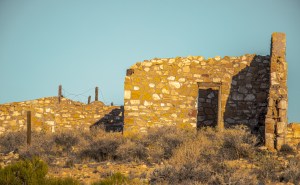
You might double back to confirm that what you thought you saw was what you really saw.
Highway exits? They’re like doors that lead to rooms off the main hallway. Exit signs convey the basics of what’s behind those doors. They tell you if there’s food: if there’s lodging; if there’s a gas station.
What exit signs don’t reveal are the sights, the stories and the lore locked in some of those rooms. Sometimes you just have to speculate whether or not there’s something worthwhile beyond the door.
But isn’t that the essence of a road trip? You see an exit sign, steal a glance off the highway and in the quickly waning moments before you’ve passed the exit, you either veer off or go on. In the case of the former you might stumble onto a rare find.
The latter? You’ll never know, will you.
In most cases you do pass by and press on. But the name Two Guns is compelling, a little bit mysterious, and very much Wild West. Hard to resist the urge.
The exit sign is simple.
Exit 230
Two Guns ↗
Nothing else. Nothing hints of the tales of Two Guns.
The recent history of Two Guns (recent being 1920) is a version of the usual story of someone trying to make a go of it along the course of once popular Route 66 in the barren Southwest. Just another rendition of the many narratives that stretch from Oklahoma to the Pacific Ocean; of dreams, plans, success, failure and a final surrender to the onslaught of progress.
That’s the unspectacular. The rest?
Two Guns offers colorful history and Wild West hokum; stories of tribal bad blood and bloody battle; of a death cave; of ghosts; of a murderous, crime ridden town; of an outlaw hideaway; of a homicide; of old fashioned karma; of business success and failure; and of – a movie actor.
The Two Guns story is a mixture of fact, exaggeration, marketing baloney, and dime novel bunk. After all, Route 66, particularly in the Southwest, wouldn’t be Route 66 without a few piles of apocryphal horse shit, and some of the early chapters in the Two Guns story are steaming road apples in a trail of droppings that enhance the appeal of the old Mother Road.
Exit 230 dumps you onto another of the many still extant spurs of old Route 66, this one leading to an outcropping of weather beaten stone structures, now little more than ruins, scattered about the hard landscape.
Many of the structures date back to the 1920s, when Earle and Louise Cundiff joined scores of other entrepreneurs who banked all they had on the idea of providing a way station for Route 66 motorists. Nobody was permanent, they were all just passing through. The Cundiff’s, who owned 320 acres of land in the area, started an enterprise that followed the recipe typical of a Mother Road venture; a café, a trading post, a filling station, and a vision of success.
There are, though, wild stories of purported events in the Two Guns area which predate the Cundiffs by forty years. Rather than documented history that was passed down through the decades, these stories surfaced more than forty years AFTER the Cundiffs started their business. The sordid history of this area emerged in 1968, from the pen of Gladwell Richardson in a book titled Two Guns, Arizona.
Richardson was a prolific writer of Wild West novels but he marketed Two Guns, Arizona as a work of nonfiction.
The Apache Death Cave
Nearby the ruins of Two Guns, Canyon Diablo, is a deep winding scar through the otherwise table flat land.
The preamble to the story of the Apache Death Cave, (and the only apparent truth in the matter), begins between the years 1000 and 1500 when, according to researchers, Athabascan speaking people, including the Navajo and Apache, migrated into the American Southwest from present day Canada.
The story of the cave is where history becomes fractured, beginning with a raid in June of 1878, by a band of Apaches on two Navajo camps; attacks which spared only the lives of three Navajo girls. A group of Navajo warriors, absent from the camps during the attack, went in pursuit of the girls and their Apache abductors. The Navajo discovered a cave just below the rim of Canyon Diablo where the Apaches and their horses were hiding.
In an attempt to smoke out the raiders, the Navajo built a fire at the mouth of the cave. The Apaches tried unsuccessfully to douse the flames with what water they had. After having used up their water, the Apaches sliced the throats of their horses and used the blood in another unsuccessful effort to put out the fire. In the end, forty-two Apaches were killed either in the cave or while trying to escape.
Is the story of the Apache Death Cave an Old West fable or actual history, decorated with blood stained hyperbole? More than likely it’s the former, as, before Richardson, there was never any existing account of such a skirmish.
Billy the Kid
Richardson’s story continues with an account about an outlaw named Henry McCarty (aka William Bonney, aka Billy the Kid) having used Canyon Diablo as a hideout during the winter of 1879 – 1880.
Richardson’s version is highly unlikely.
You see, documented history puts “the Kid” in New Mexico, in January of 1880, where he was occupied with shooting a man to death in Fort Sumner. While the actual cause of the dispute isn’t entirely clear, sources at the time said that Joe Grant was looking for “the Kid” with deadly intentions. Having been tipped off, Bonney approached Grant in Hargrove’s Saloon, and, under the guise of admiring Grant’s pistol asked if he could see it. The story continues that before returning the revolver, Bonney surreptitiously rotated the cylinder so that the hammer would strike an empty chamber. Upon receiving the gun, Grant turned it on Bonney and pulled the trigger. Imagine Mister Grant’s disappointment when, instead of hearing the report of a bullet being loosed, the only sound was that of an impotent click. In the next moment, “the Kid” drew his own revolver and shot Grant in the head. Regardless of whether or not the details are true, it’s certain that Billy the Kid was not in Arizona, but in Fort Sumner delivering Joe Grant to the afterlife.
The Railroad Town
Richardson wasn’t done, as he went on to build up the bawdy railroad town of Canyon Diablo, using as materials, pen, paper, and an active imagination,
That there was a community of railroad workers in the area, about a mile from the future location of Two Guns, is not open to dispute. To call the community a town is to lavish praise on what was more just a collection of shanties and tents, populated by the railroad workers, and the camp followers who made their living offering services that ranged from crucial to corrupt.
In December of 1881, work on the Atlantic and Pacific Railroad stopped at the east rim of the canyon. Since trains don’t fly (at least not by design), the railroad workers halted their work while a bridge across the gorge was constructed.
It would be hard to deny that good old fashioned sin, in the usual forms of gambling, whiskey and “working” women, didn’t drive the local economy of a desolate community of railroad workers, but Richardson, deciding that the story needed a little spiffing up, described a town so vicious and sin ridden that it made Tombstone look like Brook Farm by comparison.
Wrote Richardson, ‘For the brief span of its vicious life, more famous places like Abilene, Virginia City and Tombstone could not hold a candle to the evil of this end-of-the-railroad’s depravity. Murder on the street was common. Holdups were almost hourly occurrences, newcomers being slugged on mere suspicion that they carried valuables.’
Richardson described a town, with a main drag dubbed Hell Street, that was served by fourteen saloons, ten gambling houses, and four brothels. Richardson wrote that the town’s very first lawman “pinned on the badge at three o’clock in the afternoon; at eight that night he was laid out for burial.”
The problem with Richardson’s description is that no written details from the railroad camp exist. That he described the town and its goings on in precise details, including saloon names such as The Last Drink, Road to Ruin and Bughouse Joe’s, casts doubt on the entirety of Richardson’s book.
Of Richardson’s book, State Historian Marshall Trimble said, “As I’ve always been sure to say when I talk about Canyon Diablo, you have to take these stories with a very large helping of salt. Don’t discount all of it, but probably most of it.”
Offering a more pointed opinion, George Shaw, an archivist of the Arizona State Railroad Museum, said, “Nearly everything you’ve read (in Richardson’s book) is fiction. Never happened. Almost everything you’ve heard about Canyon Diablo is bullshit,” said Shaw.
In the end, the bridge was completed in six months and shortly thereafter, the railroad camp named Canyon Diablo disappeared into the flinty ground.
Until finally debunked, these stories of death and debauchery appeared for decades as bona fide history in articles and blogs.
And what of the Cundiffs?
Chief Crazy Thunder and the Gila monsters
Shortly after opening for business, they leased some of their land to a colorful character named Harry E. Miller, who claimed to be full blooded Apache. The eccentric puffed up his Indian reputation by taking on the nom d’entreprise, ‘Chief Crazy Thunder.’
By 1925, Miller had set up his own business which included a trading post and a zoo of exotic desert animals that housed mountain lions, cougars, snakes and venomous lizards known as Gila monsters. Miller named his attraction Two Guns, purportedly after William S. Hart (aka Two Gun Bill), a silent film star who carried a matched set of Navy revolvers in many of the Westerns he starred in.

In 1926, during a dispute surrounding the lease, Miller shot Earle Cundiff; shot him dead. Miller was acquitted but where the law failed, karma took over, as Miller was mauled by two of his mountain lions and bitten by one of his Gila monsters.
Miller survived and left Arizona but reportedly not before pilfering some of Louise Cundiff’s merchandise which included turquoise jewelry and silver.
Demise
Louise pressed on, building a new gas station and a new trading post after Miller’s burned to the ground. Over the years, the outpost went through a series of renewals and expansions which included motels, taverns, a campground and a resurrection of Miller’s old zoo.
In 1971, the filling station burned down. With the advent of Highway 40, travelers began to favor the destination over the journey, and the tourist trade dried out like the surrounding land. It wasn’t long after the fire of 1971 that Two Guns languished and finally crumbled into the ruins that remain.
In 2011, a story made the internet rounds that actor Russell Crowe had purchased Two Guns in order to shoot a remake of the movie Westworld. Not surprisingly, the story was just another case of internet malarkey.
Just as I did at Twin Arrows, I decide to leave Lexi in the van. The ground is rocky and littered with debris and the crannies and crevices certainly provide havens for snakes. I stumble around the ruins, taking pictures while trying to imagine what the place must have looked like during that short time before ‘Chief Crazy Thunder’ shot Earle Cundiff, sending the Cundiff dream on its death spiral.
It’s a hard thing to imagine this rubble as a once thriving tourist stop where families stopped for a meal, shopped for trinkets, marveled at Chief Crazy Thunder’s zoo and posed for pictures taken with box cameras. This lonely place, where now a false step can break an ankle, was once manicured with roads and paths, where running children were admonished by strolling parents, “Don’t get too far.” There was a time when Two Guns was alive with sounds; with conversation and laughter; with mom and dad arguing over something because that’s what parents do on a vacation; with eggs and bacon sizzling on a flat top; with the “ding” of the old filling station bell and the now seldom seen and heard gas jockey asking, “Fill ‘er up?”
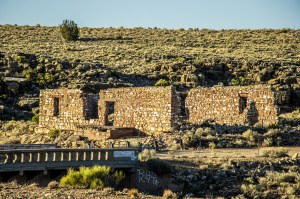
Now? Now the only sounds are of the big rigs roaring by on Highway 40 and of the dry rattle of wind blown desert brush, where at one time flower gardens must have decorated the grounds.
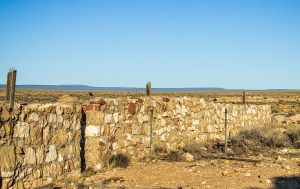
These old ruins don’t hold any hint of past life. It’s almost impossible to think of these stone corpses as ever having held any human souls. Looking about, I can’t even imagine these structures as being man made. They can only be some odd natural rock formations. It is a fascinating, and yes, haunting place, and if I believed in ghosts I could imagine them flitting through the crumbling walls and lurking behind piles of rubble.


There is indeed a cave nearby. Was it at one time a death cave? At this point, I suppose it’s what the individual has read or wants to accept as fact. But that’s the way it is with a lot of things these days, isn’t it.
I’d stay longer and venture further but I want to keep the van, where my dog is waiting, in plain view.
After an hour or so of exploration I get back in the van, “Ready for breakfast Lex?”
Cora is up and having her breakfast and morning coffee.
Packed up, we’re headed east on Highway 40. Next stop, Grants New Mexico. On the way we’ll stand on a corner in Winslow, Arizona and, later, view the grandeur of the Painted Desert.
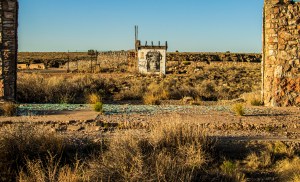
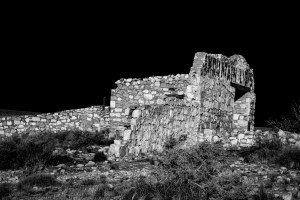

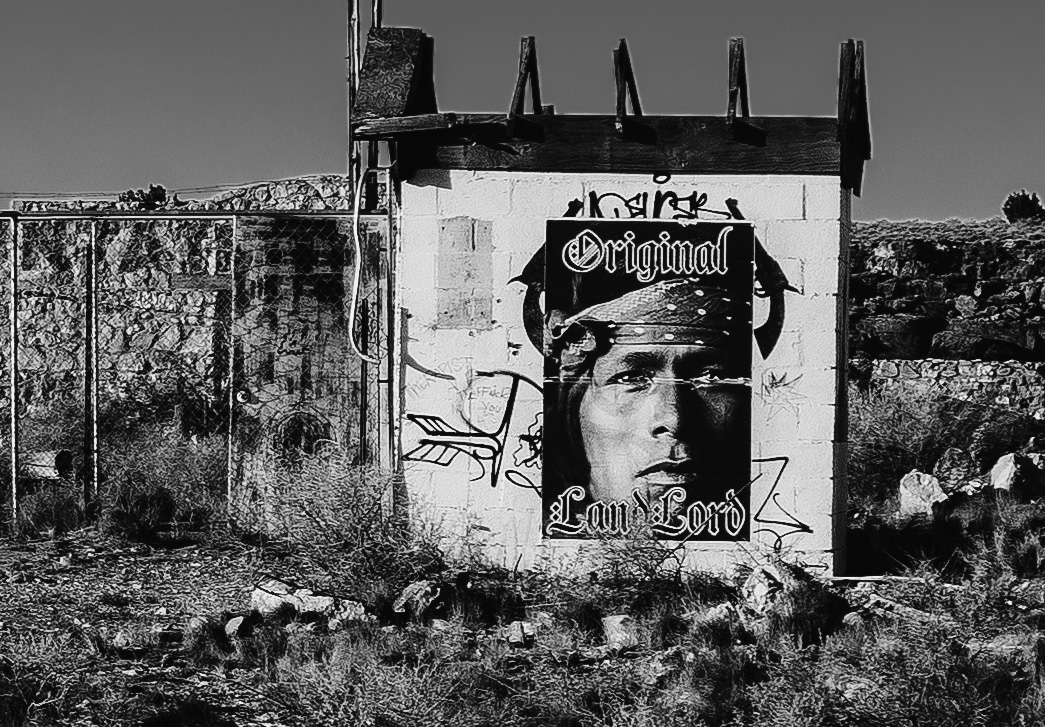

Fascinating tales as always, even if very few of them are true! You do a great job of conjuring up the true past atmosphere of this place and that’s sufficient history for me! But I was interested in the non-existent links to Billy the Kid, as we visited his grave in Fort Sumner and indeed ‘followed him’ around New Mexico 🙂
LikeLike
Hello Sarah, You are correct about Billy the Kid. As I pointed out, Richardson’s book places him, incorrectly, at Two Guns during the time that he was shooting a man at a saloon in Fort Sumner. I am curious if you learned anything about the “the Kid’s” alleged tampering with Grant’s gun before shooting him.
Thank you for visiting and commenting.
Paul
LikeLike
This was an interesting read. Isn’t it funny that most of the old structures that are still standing are those with windows or doors? Maybe those are just the parts that get photographed because they look more interesting than just walls, but your pictures look like that’s what’s left.
LikeLike
Hello RR,
What you say about the structures with window and door openings appearing in the photos is true. Maybe the reason I gravitated to those structures is because they looked like something more than just a plain rock wall.
Thank you for reading and commenting.
Paul
LikeLike
I have long owned a book titled WESTERN GHOST TOWNS, which I took from the shelf and dusted off to see if TWO GUNS is included in the 21 Arizona ghost towns in the book. It is not, but I’m glad I went to the trouble because (like your post) it’s full of interesting details and photos which I haven’t perused in decades (the book was published in 1961). I’m sure you would love it, but it’s probably out of print.
LikeLike
Western Ghost Towns, by Lambert Florin is available from Abe Books, an Amazon production that sell rare, used and out of print books. Bezos has his fingers in everything.
I’ve always found the American West to be a fascinating subject. I took a college course that was titled The American West. Fascinating but it’s legacy unfortunately lives on in the form of our gun culture.
Thank you for reading and commenting,
Paul
LikeLike
If we hadn’t taken random exits from the Highways, we wouldn’t have eaten at Peggy Sue’s Diner, well worth it just to see the over indulgence in nostalgia. Nor would we have visited Calico, which, funnily enough, was, allegedly at least, a railroad construction town before it hit the riches of a “silver rush”, with saloon bars, brothels and other dens of iniquity defining its character in much the same way as the fiction surrounding Two Guns. Those deviations from the Highways are, as you say, the very essence of a road trip.
LikeLike
Thank you for reading and commenting. There was a time when the journey was part of the adventure. Now, with everything and everyone in a hurry, the destination has become the sole goal and the getting there an annoyance.
The Wild West certainly was a colorful, if violent and wicked time.
Paul
LikeLike
I guess a remake of Westworld’s one of those that I wouldn’t mind…although now they have the series, so that won’t happen. But no one could ever replace Yul Brenner, of course, lol.
LikeLike
Hello Stacey, The Westworld/Crowe/Two Guns connection had a sort of time warp to it. I guess there was talk of Russell Crowe being cast in a remake and then in 2020, word surfaced that Crowe would not be cast in a remake and then it was a year LATER that the rumor about Crowe buying Two Guns of the remake made it’s appearance. Ah, the internet.
LikeLike
“Highway exits? They’re like doors that lead to rooms off the main hallway.” So true. There are so many of these stories to come across. My husband finds these random places too and loves reading about the history of the area. I might be with Cora drinking coffee. Well done. Donna
LikeLike
Hello Donna, Thank you for visiting and for following.
Yes, Cora and I have a pretty good arrangement. I can go out and do my photo thing and she can sleep in and have a leisurely breakfast.
LikeLike
Always great photos and stories. Many thanks Paul.
LikeLike
Finally caught up to this blog from September, Paul. I must say this was a fascinating read, but the pictures really struck me. They’re little more than rock walls, but even in black and white, they have colour and presence. They’ll be here long after we’re gone, and the stories will continue, whether they’re true or not.
LikeLike
Hello Eden,
I wish I knew the stories about Two Guns before visiting. I might have done more exploring.
I agree that the stories will be around but you never know about the physical place. Vandals can be relentless.
Paul
LikeLike